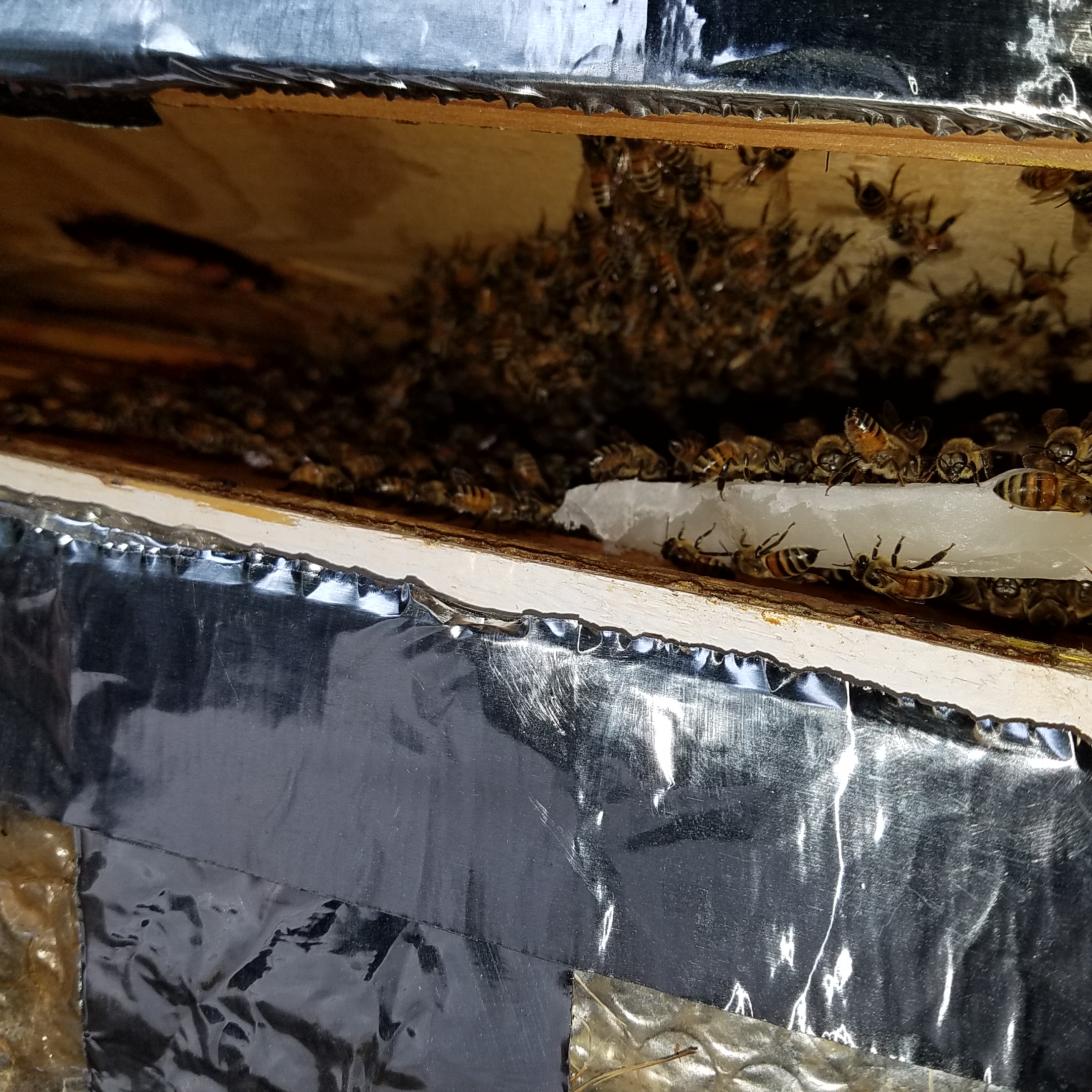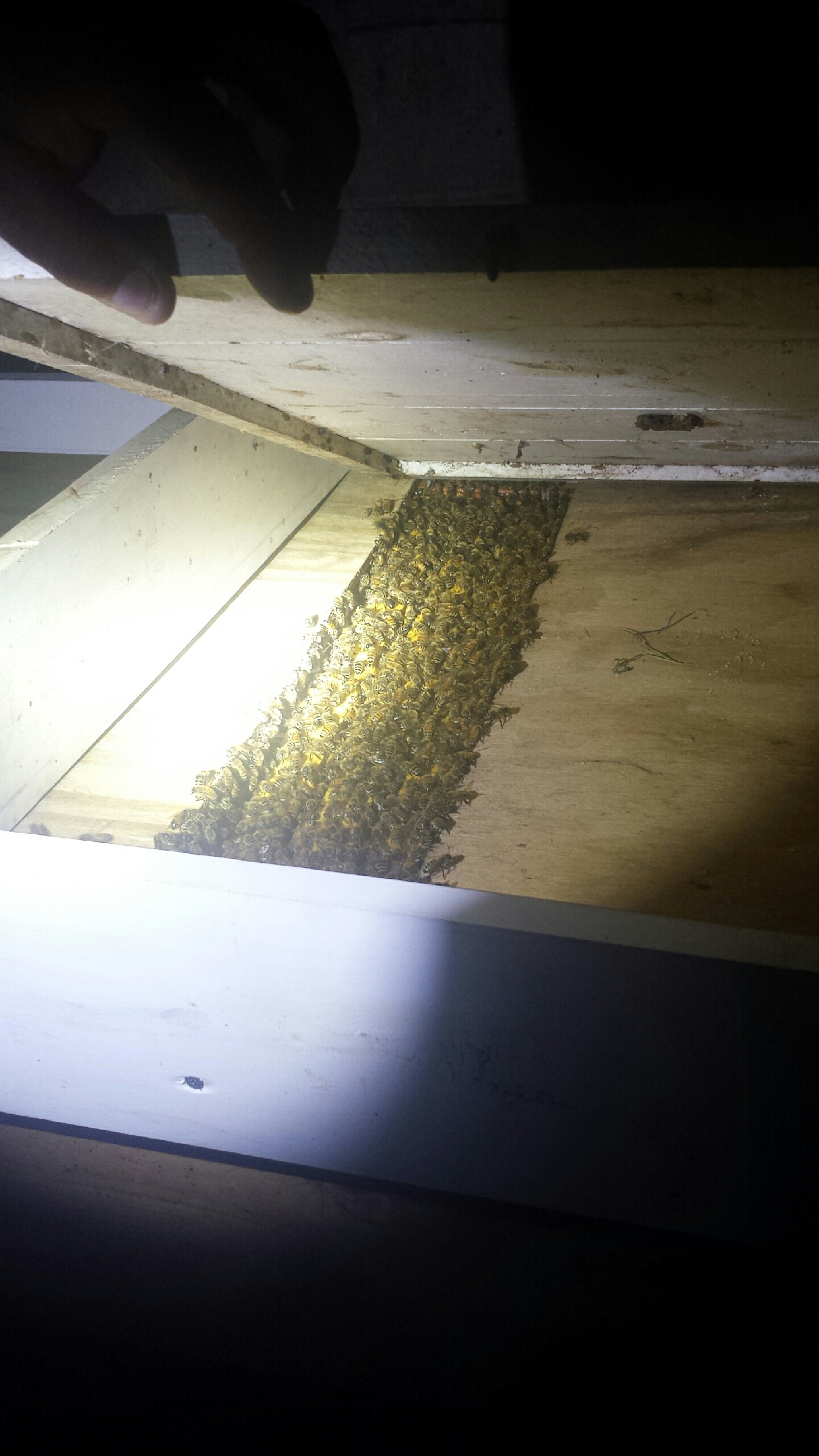Product / Service #1
-
WHAT IS A BEE SWARM?
Swarming is the honey bee’s method of colony reproduction. The old queen and about half of the worker bees leave their former nest and seek a new home, usually in the spring but sometimes at other times of the year when local conditions permit. To start the process, certain worker bees, called “scouts,” begin to canvass the surrounding territory for a potential new nesting site even before the swarm leaves its original colony.
A departing swarm consists of a large number of bees flying in a cloud that seems to drift along through the air. People not familiar with honey bees are generally frightened by such a mass, which can contain 5,000 to 20,000 bees, but unless a bee becomes tangled in someone’s hair, it isn’t likely to sting. The queen is in the group, but not leading it. Usually within 100 to 200 yards of the original hive, the bees alight on an object and form a cluster, which looks like a seething, fuzzy glob of insects. Sometimes bees fly from the cluster to collect water and food, but most workers leaving the cluster are scouts that search out potential new home sites for the swarm. When they return from a good site, they dance on the cluster to communicate the location of their find.
A clustered swarm of many bees may appear frightening, but most spring swarm clusters of European honey bees—the common honey bees in central and Northern California—are extremely docile. It takes quite a bit of stimulation, such as being hit by sticks and stones or squirted with a hose, to induce defensive behavior. The same may not be true for Africanized honey bees or for any swarm of honey bees that has run out of food, as these aren’t nearly as predictable and can be very touchy, even as swarm clusters.
Honey bees will nest in cavities having a volume of at least 4 gallons but prefer cavities around 9 gallons. Honey bees also prefer dark cavities with an easily defended entrance that is at least 9 feet from the ground. Hollowed-out trees are ideal sites. However, honey bees may nest in all sorts of cavities such as inside walls of houses; in or around chimneys; in outbuildings, fences, shrubs, water meters, utility boxes, barbecue grills, and soffits; or under decks. Within a few hours to a few days, the swarm’s scouts usually reach a consensus about the best available site. Then the swarm takes to the air one last time to move to the new home.
Once in flight, the swarm is guided by scouts and arrives at the new site. It forms a cluster around the entrance with many bees fanning their wings and releasing a chemical signal to guide the others. Then the bees enter their new home, somewhat slowly. This is what most people notice when they see bees clustered on a section of a building. Inside, the low humming sound of the bees ventilating their nest often can be heard.
If the bees don’t find a new nesting location, they may begin producing beeswax and forming combs at the spot where the cluster formed, such as a tree limb, the overhang of a house, or another unusual place. These “exposed comb” colonies may exist until fall (or year-round in warm-winter areas), but robbing bees, hungry birds, and inclement weather usually put an end to these colonies and their combs.
Product / Service #2
DAMAGE
While they may look frightening, bees that are swarming and carrying honey from their old hive are much less defensive or likely to sting than they would be if they were protecting brood (immature bees) at the old hive. They shouldn’t pose much danger if left undisturbed but will sting if provoked. For information about bee stings, see Pest Notes: Bee and Wasp Stings.
Once bees become established, they will begin to build combs for rearing brood and storing food. Although colonies may do no structural harm to the building, occasionally they use water to soften Sheetrock and remove it in order to expand the nesting area. Residents then will notice an enlarging damp area on their wall. In a few cases, the bees actually open a hole through the Sheetrock so that foragers escape into the house, annoying or scaring occupants. Finally, if the colony is killed and not immediately removed, honey will ferment and leak through walls and ceilings, causing damage.
Product / Service #3
Swarm Clusters
Swarm clusters—the correct term for swarms when they aren’t flying—are ephemeral by nature and therefore generally don’t need to be managed. Whenever the bees locate the proper new nesting site, the swarm will fly off to the new location. The bees usually leave a bit of beeswax at their clustering location, so appearances of additional swarms at that same place can be anticipated in the future.
If the cluster needs to be removed, call a beekeeper. Experienced beekeepers often remove clusters simply by brushing or shaking the bees gently into a cardboard box and carrying them away. Ideally the box should have an entrance that enables the flying bees to join the already-captured group. Place the box in the shade until nightfall then seal and remove it after dark. The beekeeper should be prepared for defensive behavior by dressing in a bee suit, but dealing with a cluster is usually quite easy. It becomes more difficult, however, when the cluster is hard to reach, such as up in a tall tree, intermeshed with the branches of a shrub, or wedged into the corner of a building.
Removing Established Colonies from Your Home
Extracting honey bees from buildings is considerably more difficult than collecting swarm clusters. When the colony is first established, only a few pounds of adult bees are present, but these bees rapidly build combs, collect honey, and begin to rear more bees. A well-established colony may have up to 100 pounds of honey, many pounds of adult and developing bees, and many beeswax combs. Removing such as nest is a challenge. The first step is to determine the exact location of the combs and size of the colony.
Although honey bees can be killed in place inside buildings by using pesticides that are labeled for killing bees inside of structures, this removal option often leads to undesirable consequences. (Note: These chemicals are available only to licensed pest control operators.) If the adult bees fall into a large pile, they may hold their body moisture and rot in place, producing a very bad odor. Liquid from the decomposing mass frequently penetrates the structure, leading to costly replacements.
If the colony is well established, there are further issues associated with killing the colony. Unattended brood can also rot and become very odorous. Unattended honey stores can absorb moisture and ferment, creating gas that causes the cappings holding honey in the cells to burst. Gravity will start moving the honey down attached surfaces until it encounters a horizontal impediment, such as a window frame, doorframe, firebreak, ceiling, or floor. Honey then seeps through the drywall, leading to large amounts of cleanup and expensive replacement. If pesticides were used to kill the bees, then the honey, wax and, dead bees are contaminated and must be handled as hazardous waste.
A better procedure than applying insecticides, especially if you have a beekeeper who is willing to help, may be to eliminate the bees without killing them. First the beekeeper will need to locate the nest by tapping the wall and listening for the hum of the colony. Some beekeepers rely on stethoscopes to find the edges of the nest. Others drill extremely small holes in the wall and insert a fine wire to find the periphery of the nest. To take honey bees and their combs from the nesting spot requires opening a fairly large hole in some portion of the building. That is best done by a professional contractor so that the hole can be easily closed after the bees are removed.
If the bees are to be saved, the beekeeper gently removes them and their combs. If the bees aren’t going to be saved, they can be removed from the void with a vacuum device such as a Shop-Vac. This process tends to stimulate the bees to release an alarm pheromone that smells like bananas and increases defensive behavior, so everyone nearby must be fully clothed in a bee suit. Many beekeepers have baffles and collection containers in their vacuum lines to try to protect and save the bees. If the homeowner has a lot of patience and knowledge, the bees can be “trapped” out of the building using a one-way wire screen device that forces bees that leave the building to relocate into a beehive placed adjacent to the original entrance. For more details see Removing Swarms and Established Colonies from Private Property.
If you can’t find a beekeeper to help, call a pest control company with experience with bee removal. Be aware that pest control companies generally will kill the bees before removing them. Don’t try to remove the colony yourself unless you have experience and proper equipment.

Next Steps...
Call anytime to talk to me personally, Tim McDowell, 301.748.8372
Ill get to your project ASAP
Or email me at usanimalcontrol@gmail.com
Feel free to send pictures of your bees and where they are invading
Consider the service area, the entire state of Maryland, Northern Va. And The District of Columbia.
Look on further pages for more service info


